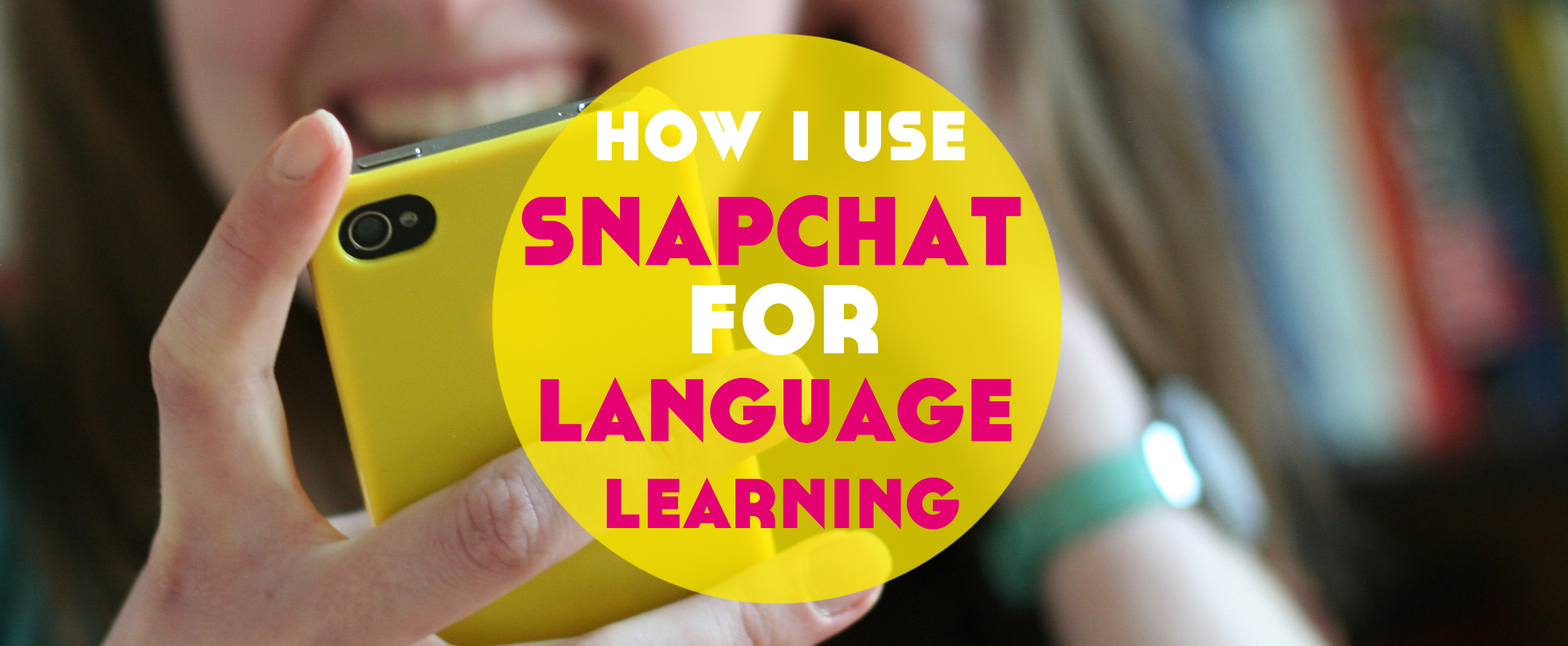January 11th, 2016
How I Use Snapchat for Language Learning (+ free downloadable guide!)
After the last post focused on goal setting, in this post, we’re turning our attention to social media and how to make the most of it for language learning. In this post, I’m sharing how I use Snapchat for language learning. Time to get snappy.

One thing that’s great about the Internet is what it’s done for language learners. We’re connected. We can share ideas, motivation, and progress with the aim of encouraging each other to keep going.
I also love YouTube in particular for this reason.
However, the problem with YouTube is that if you want to practise your languages, whatever level they may be, they’re left there in the open, out of context for all the world to see for as long as you wish to keep them public.
This is great and you may well get comments of encouragement and motivation. But it may not always be constructive.
A while ago, I was considering sharing regular multilingual vlogs on YouTube with an aim to practise more of my languages, including the ones that don’t get a look in because I’m not actively studying them, as well as the aim to share some more “raw” content with you.
I was all set to go and didn’t really care about the negative comments I’d get from the inevitable errors of a person babbling away in languages that she hasn’t studied for years.
However, something was holding me back. Maybe I wasn’t set for the negative comments after all.
YouTube is wonderful, but my advice would be simply to ask yourself one question before posting a comment there or anywhere else on the Internet: would I say this to the person’s face?
Anyway, this blog wasn’t supposed to be about YouTube.
It’s about Snapchat. And Snapchat filled that void for me.
Snapchat allows me to share daily snippets of my life in different languages, it allows you to get a more personal and unedited look at my life and my language learning, and it allows me to do this with no fear of negativity coming my way.
Here’s the thing – Snapchat doesn’t have comments, or likes, or dislikes, or sharing.
And you know what else is awesome for impromptu multilingual stories? They’re deleted after 24 hours.
You have the option to save them for yourself of course, but you have no “profile” as such with a stored history of your every mistake.
So if you too are looking for a space to practise out loud but in private, if that makes any sense whatsoever, Snapchat could be just what you’re looking for.
Shall we start by being totally honest? Snapchat wasn’t easy to figure out from the get go.
I spent a lot of time watching YouTube videos and reading blogs about how to use it. It didn’t make any sense to me!
Your Free Guide
I’ve explained how things all work in a Bonus Guide that you can download to your inbox riiiiggght abooouuut now by clicking the image below. Grab your guide, and then read the rest of this post to understand how to use this versatile tool for language learning. Ready? Let’s go!
What is Snapchat?
Snapchat is one of those social media platforms that is so often associated with the younger generation, so you’d be excused for reading this if you’re over 19 and feeling like you’ve just discovered your first grey hair. Vomiting rainbows and bad press about teenagers sexting may be the only thing you’ve heard about this incredibly versatile app, but there’s so much more to it that that.
Here’s everything you need to know in 5 bullet points:
That really is the barebones of Snapchat.
Their Support pages on their site have a clear and detailed guide on everything from how to download the app to how to add the current temperature to your Snap. I know, right?!
Related: The Quick Start Guide to Instagram for Language Learning
How to Use Snapchat for Language Learning
Daily Multilingual Vlogs
The way I started using Snapchat was to practise various languages throughout my day based on my day. I’d share my breakfast in Italian, my working day in French, and my study time in German.
Taking those little moments and translating on the spot made for a great way to practise my language learning.
It’s pretty darn versatile too.
My personal preference is to speak in the target language, write text over the top of the clip with an English translation, and then select and emoji flag for the language I’m speaking in that clip to put on screen too.
Here’s an example of a Snapchat Story I saved to my phone back in October. YouTube doesn’t seem to recognise the photo stills, so excuse those grey screens – that’s where there’s a photo!
However, you could completely flip that on its head and speak AND write in your target language, or speak in English and write in your target language. So many choices depending on how to you want to best use the app for you at whichever stage you are at with your language.
Related: The Quick Start Guide to Pinterest for Language Learning
New Vocabulary
This is where most textbooks and pre-created courses fall down. And, let’s be fair here, it’s because they don’t know your life.
They don’t know that you’re a blogger and the words for meta tag, blog, and plugin will be more useful for you than “Where is the train station?”
Or that you love waterskiing and want to talk about this in the language you’re learning for a competition.
Or that you’re in the National Pug Lovers’ Club and have a rather niche vocabulary to learn to connect with your French counterpart.
You get the idea. We all have our own interests, jobs, and hobbies. And chances are we’ll want to talk about them in our target language.
Chances are also that these things will be part of your daily life.
Take photos (or ‘Snaps’) of the new vocabulary items across your day and save them to your Snapchat Story.
Later in the day, watch it back and with your trusty dictionary at hand, get to work looking up these words for the things you’d never find in a textbook.
You can even then record a video Snap of you reciting your new vocabulary, save it to your phone and you’ve just created your own personalised language learning resource with pretty minimal effort. Woohoo!
Related: The Quick Start Guide to Facebook for Language Learning
Speaking Practise
So if the thought of sharing snippets of your daily life via multilingual vlog or vocab hunt doesn’t appeal, here’s one that might just be for you.
Use Snapchat as your accountability for speaking practise on days when you don’t have a language exchange or lesson scheduled.
It sounds ridiculous, but most weekday mornings, I speak a little Japanese even when I don’t have a lesson by using Snapchat as a way to hold myself accountable. It’s perfect!
Most mornings during my study time I’m still dressing-gowned-up and sleepy-eyed, so I don’t even have to show myself, but more often, the words I’m reading.
Related: The Ultimate Guide to Language Learning Podcasts
Your Free Detailed Guide: How to Use Snapchat for Language Learning
Feeling inspired?
If you want to give Snapchat a go for your language practise, download your free X page guide on how to do just that. It covers the points in this guide in more detail as well as giving you some tips on how to overcome shyness with using a tool like this.
Click the image below to get your guide. Yay!
Give it a go and follow me by searching ldlanguages to get you started. I look forward to sharing my imperfect language learning with you on Snapchat!
Do you use Snapchat for language learning? How do you make it work for you? Or maybe you’re feeling inspired to try it out now? Share your thoughts in the comments!







